Thunderstorms can be quite dangerous when camping and lightning strikes do hit a small amount of campers and hikers every year.
If you've got a storm rolling in you might be wondering whether or not it's safe to be in a tent during a lightning strike or thunderstorm.
Tents are not safe places during thunderstorms and do no provide any protection from lightning strikes. While tents don't attract lightning, they don't ground the energy safely and you can be electrocuted.
When lightning strikes a tent it travels down the poles into the ground causing a ground charge which can then travel through the ground and through the people in the tent which can lead to injury or fatality.
If you're camping during a thunderstorm your best option is to seek refuge in a vehicle or fully enclosed building with plumbing or electrical wiring (not a gazebo or similar structure).
If a vehicle is unavailable then being outside your tent and away from lone standing trees and in the crouched lightning position (ideally on top of some sort of mat) is going to be safer than being inside your tent. Lying down during a potential lightning strike is NOT recommended.
Tents don't technically attract lightning and if you pitch you tent in the correct location then it can be relatively unlikely that lightning will strike you.
Why Tents Are Unsafe During Lightning Strikes
If you're like me you may have falsely assumed that during a thunderstorm staying inside your tent is a relatively safe space to be.
Unfortunately, staying in your tent to protect your from lightning is the equivalent of pulling the blankets over your head to protect you from monsters. It might make you feel safer, but it won't actually make you safer.
There are a couple of reasons tents are not safe places to be during lightning strikes.
Tents Are Kind Of Tall and Semi Conductive Making Lightning Strikes More Likely
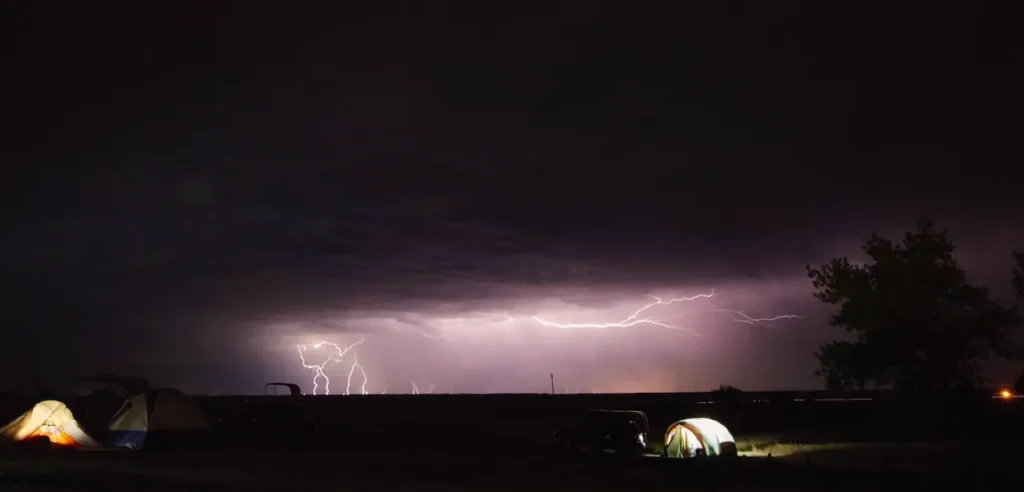
You're likely aware that lightning likes to take the shortest or easiest path to the ground.
Like tall trees or building tents do have some height to them which can make them a more likely target for a lightning strike.
Most tent pole nowadays are made from carbon fiber and aluminum and while this is nowhere near as conductive as the old steel tent poles my dad still uses on his canvas tent, they are still fairly conductive.
Lightning is more likely to be attracted to conductive materials and thus the tent poles can potentially attract lightning.
It can also happen that lightning hits a nearby tree and a side flash happens where the lightning jumps from the tree directly to your tent. This is why choosing WHERE to pitch your tent is one of the most important things to do.
Ground Currents Can Kill You
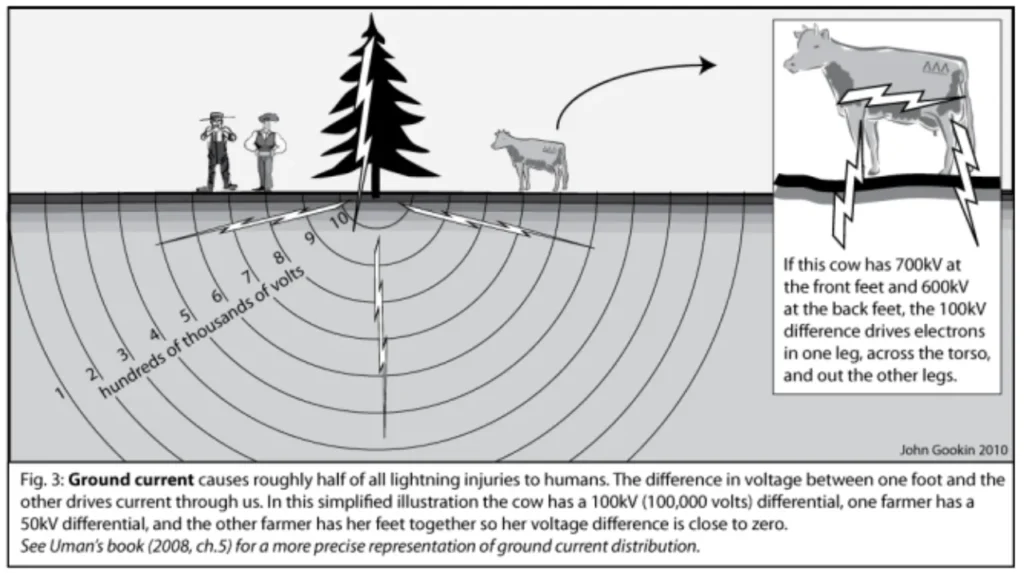
When lightning strikes a tree or your tent it doesn't just stop there. The electrical energy (which can be millions of volts) needs to go somewhere.
This energy will travel down your tent poles and into the ground where it will then be dispersed through the ground. This is known as “ground current” and it can be extremely dangerous and many livestock die each year due to ground currents.
This ground current can travel up to around 60 feet or 18 meters away from the source of the lightning.
If you have 2 points of contact with the ground then the voltage difference between one side of your body and the other causes electrical current to travel through you. The bigger this difference, the more current and the more chance of serious injury or death.

This is why the crouch lightning position is recommended and lying down during a lightning strike is one of the worst things you can be doing.
The Safest Place To Be During A Thunderstorm
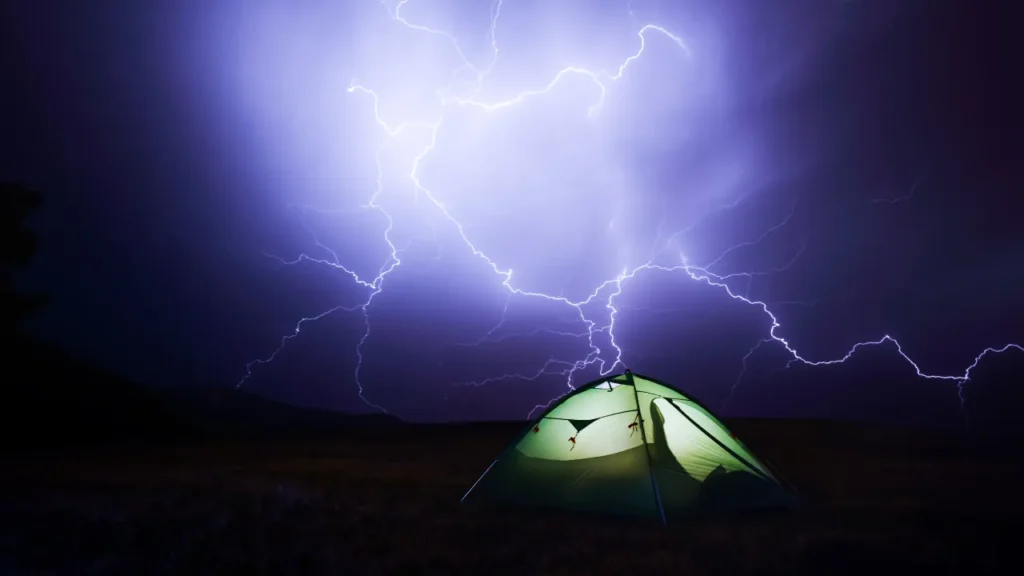
Given that a tent is NOT a safe place to be during a thunderstorm what is a safe place to be?
When camping your best options are going to be either a vehicle (like an RV or car) or a fully enclosed building with plumbing or electrical wiring.
Vehicle
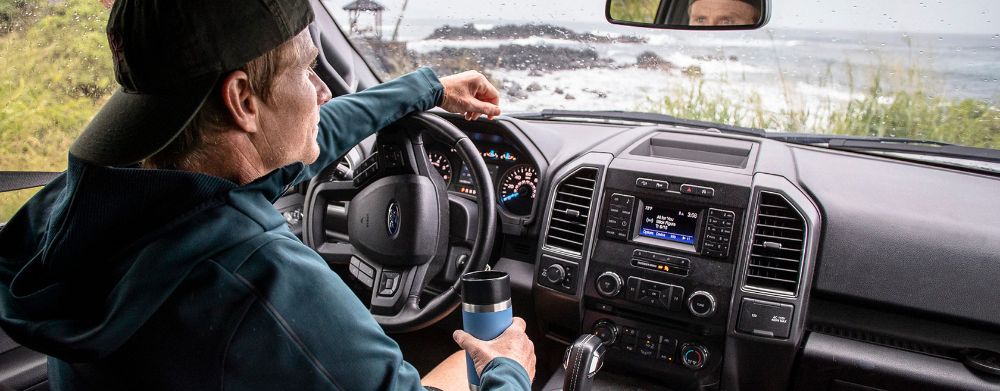
Being inside a vehicle is surprisingly one of the safest places to be during a lightning strike.
This is because the metal container of the vehicle creates what is known as a faraday cage.
This means that when the lightning hits the vehicle the energy travels around the outside of the vehicle into the ground and the contents (or people) inside the vehicle are not exposed to the electric charge at all.
The quick video below explains this process well.
However, when inside a vehicle you want to make sure you aren't touching anything metal otherwise the electric energy can travel through you.
Avoid door handles, gear sticks, electrical buttons or touching the side doors or windows.
Fully Enclosed Modern Building
Another safe place to be is inside a fully enclosed modern building which contains plumbing or electrical wiring.
This could be a house or local amenities/toilet block. The plumbing and electrics will help distribute the electrical energy more widely decreasing your chance of electrocution.
Just make sure you aren't touching any of the electrical sockets or metal parts of the building structure or plumbing.
Avoid open buildings like gazebos and small shacks as they will distribute the electrical energy unevenly and you can still be affected by ground current.
Deep Inside Caves
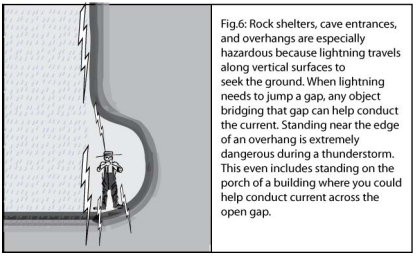
The entrance to caves or under shallow ledges are NOT a safe places to be because electrical energy can travel through the gap.
However deep inside cave is relatively safe from lightning compare to being out in the open.
Outside In The Lightning Position
If you have no building, vehicle or cave available to you then being outside crouched down in the lighting position is going to be a safer option than remaining inside your tent.
The crouching lowers you to the ground, making you stand out less and thus less likely to attract lightning and the crouched position with your feet extremely close together decrease the voltage difference if lightning does strike near you and thus the chance of you getting injured is less.
How To Increase Safety In Your Tent During A Thunderstorm
Being trapped in a tent during a thunderstorm may be a terrifying experience.
Even though you can't be sure you'll be safe, here are some things you can do to stay safe when you're stuck in a tent during a storm.
Pitch Your Tent In The Correct Location
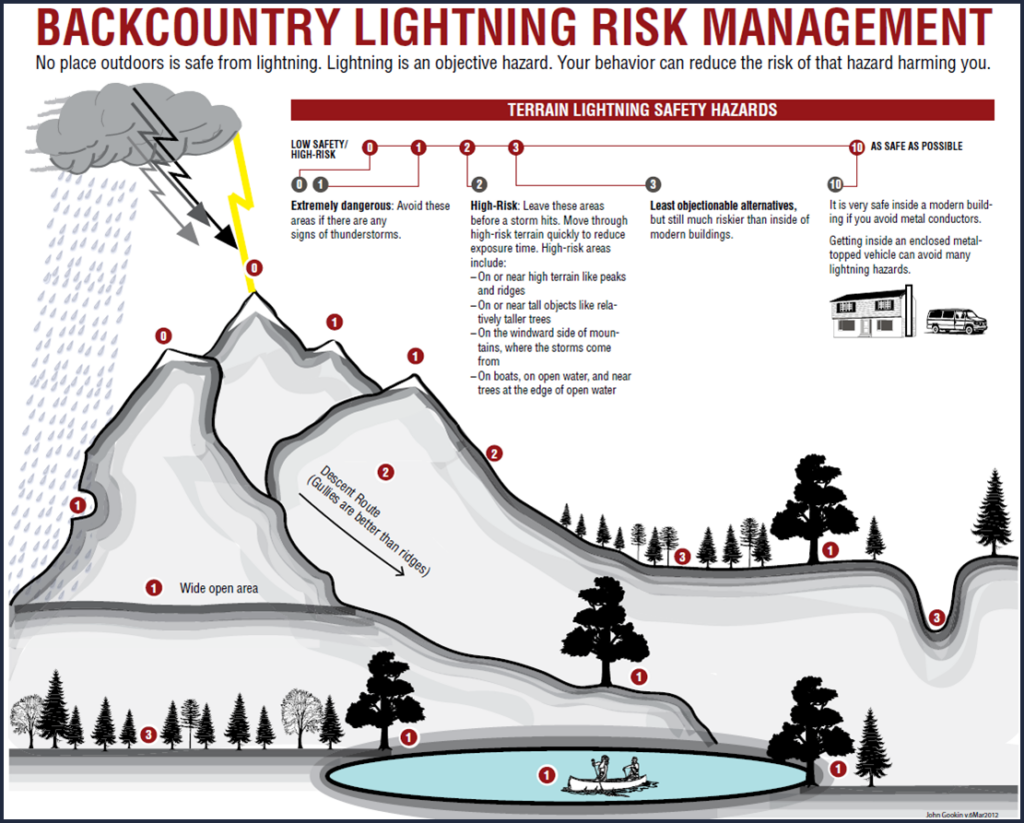
One of the most important things you can do to keep yourself safe from lightning in a thunderstorm is to pitch your tent in the correct location.
The above diagram shows the different safety levels of different locations with 0 being the highest risk and 10 being the the lowest risk.
You'll notice that even camping in the lowest risk area still only gives you a 3/10 safety rating compared to a modern building or vehicle which gives you a 10/10 safety rating.
Avoid Being The Highest Point
Lightning wants to find the fastest and easiest way to the ground. If you or your tent is the highest point in the area (eg. on the top of a mountain or ridge) it's much more likely to be struck by lightning.
Avoid Exposed Places
Exposed areas such as large fields or river banks makes you and your tent stand out as a lightning rod and will make you more likely to be struck as you are much taller than anything else in the surrounding area.
Avoid Edges of Forests
Edges of forests are particularly dangerous because you have an exposed area on one side and tall trees on the other. Lightning is likely to hit the tall trees and then travel through the ground to you.
Get Below The Treeline
If you're camping above the treeline you're going to stand out and be more likely to attract lightning. Consider moving lower down where there are multiple trees that you can camp around.
Don't Pitch Your Tent Under Freestanding Trees
Freestanding trees pose the same sort of risk as camping on exposed places. The large freestanding tree is more likely to attract lightning and the ground current or side flashes or lightning can get you.
Check out how this lightning flash travels along the ground and nearly hits these extremely lucky people:
Don't Pitch Under Widow-Maker Trees
If trees fall on your tent, you might die. Never pitch your tent under dead or weak limbs! If lightning strikes these trees limbs could easily fall off.
Avoid Having Your Tent In Large Puddles
Water conducts electricity and while the ground will get wet during a storm anyway you don't want to be in puddles if you can avoid it. The more resistance the electricity has before it gets to you the better.
Spread Tents Out
You and your tent are lightning rods. Remember that a lightning strike will will spread across the region. So, if you have four people in your tent and lightning strikes it, everyone will be startled or injured.
So the solution is to keep your tent mates as far apart as is feasible if you must be in your tents during a storm.
If lightning hits you or anybody else, It won't electrocute anyone in the other tents and they can come to your aid.
Remove All Metal Objects From Your Tent
Metal objects like old tent poles, cooking pots and pans, camp stoves, electronic devices and even utensils can attract lightning. Place these objects outside and at a distance from your tent.
Situate Yourself Away From Tent Poles
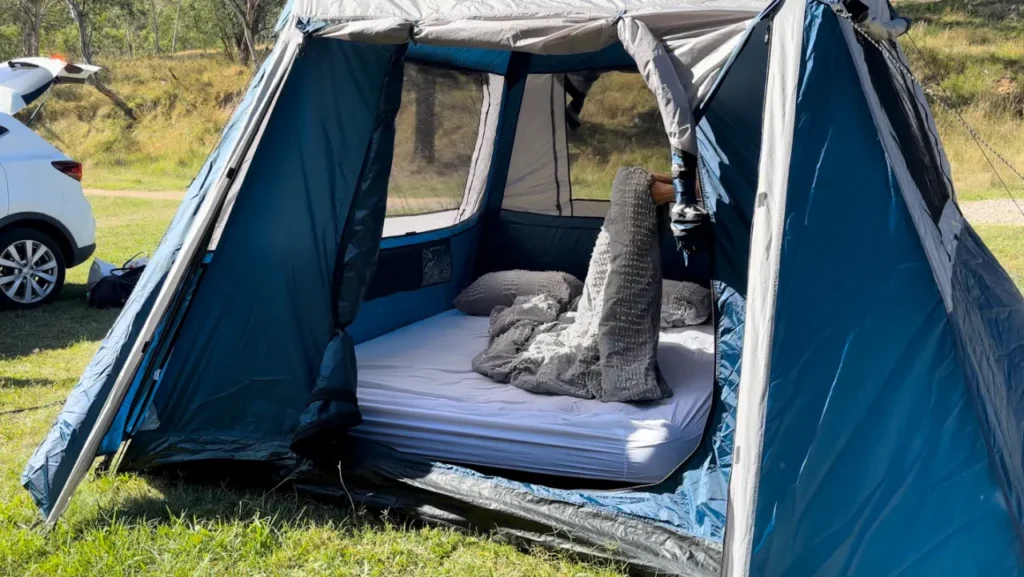
If you're stuck in your tent during a lightning storm, move to the middle of your tent.
When lightning strikes, it could strike one of your tent's poles and move through it, so try to stay away from them if you can. The further the better.
If your tent has a pole in the center, try to remain as far away from it as possible and make sure no part of your body touches it.
Don't Lie Down
Lying down is one of the worst things you can do during a lighting strike as the energy differential between your head and feet can be extremely large causing a huge current to flow through your body potentially injuring you or killing you.
Assume The Crouched Lightning Position (On Top Of A Mattress or Anything To Raise You Above The Ground)

The crouched lightning position is the safest position to be in if there is a potential lightning strike.
Crouch with your feet together on top of your mattress or anything to raise you off the ground and increase resistance to electrical current (you can use sweaters, your backpack, pillows or plastic bags etc).
Keeping your feet together minimizes the energy different between one point of contact with the ground and another and even if you are struck the current in this position the current is more likely to run up one leg and down the other – avoiding your vital organs.
In this story where a woman and her family were struck by lighting when camping she received a greater shock from ground current than her child in a hammock or a child standing on some rocks.
Technically standing on one leg should be even safer but this is unsustainable for most people and could lead to falling and exposing yourself to more risk.
Keep Your Shoes On
When in the crouched position keep your shoes on to increase resistance to electricity and thus protect you from an even worse electric shock.
Use The 30/30 Rule
The 30/30 rule states:
- If you can hear thunder under 30 seconds from when you see the lightning you are at risk of a lightning strike and should move to safety.
- You should only come out of your safe area once 30 minutes have passed without lightning.




